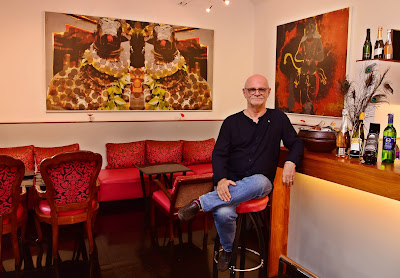Photos: Work
by Anandaraman; NN Rimzon's charcoal drawing and Narayanan
Mohanan's 'The Other 99 Percent'. Pics by Melton Antony
“The horse is crossing a
fractured nation,” he says. “And even though the land has been
partitioned, the heart beats the same for both places. I am not
hinting at the India-Pakistan partition of 1947. I am talking about
how nations come into being and the existence of borders everywhere.
We also create borders within our minds.”
At the right side, there
are several flying birds like eagles, pigeons, crows and sparrows.
“There are two types of nations: ethnic and civic,” says
Anandaraman. “In ethnic nations, there is one ethnicity, like in
Japan or China. But in countries like India, there are all types of
ethnicities that comprise a single nation. That is what I wanted to
represent through the different types of birds.”
A little further down is
NN Rimzon's simple charcoal drawing of two tiled roof houses next to
each other, with an overhanging tree. It seems like any ordinary
house, till Rimzon says it is the house of one of Kerala's greatest
poets N Kumara Asan (1873-1924). “The house has been preserved at
Thonnakkal (near Thiruvananthapuram),” he says. “It was the
place where Asan used to write his poems. His vision and social
commitment are qualities to be admired.”
Another work which can be
admired is Babu KG's 6' x 5' oil on canvas. It shows a young girl
standing in thick foliage, and staring with unblinking intensity at
a butterfly which is peering into a flower. He got the inspiration
for this work when, one day, while walking in Wayanad, with members
of the Adivasi community, he saw a girl looking at a butterfly.
Babu was struck by her
innocence. “I have noticed that people who live in the forests and
have close contact with Nature have a heightened sense of innocence
as well as divinity,” he says. “In the cities, the people become
mechanical and hard-hearted. So, I wanted to show the innocence of
the girl and the rich biodiversity of the forests.”
Meanwhile, right at the
centre of the hall, on the floor, is a 3' high black bell, made of
foam, with a hook on top. There are several black, white and brown
rats which are running away from the bell. This work, by Narayanan
Mohanan, is called, 'The Other 99 Percent'. It has been inspired by
the Aesop's Fable of 'Who will bell the cat?'
Meanwhile, after handling
the huge task of setting up and running the Kochi Biennale, Founder
Bose Krishnamachari has now done a work called 'Stretched Bodies'.
“Since the medium used was acrylic, it dries off very fast, so I
had to create a work with rigour and energy, pleasure and passion,
freshness and warmth,” says Bose. “The aim is to reflect
optimism. So, it is full of colours, and psychedelic textures.”
The show was curated by O
Sundar, who, along with a group of fellow artists and art lovers, set
up the Cochin Artcube last year. “There are artists who were
finding it difficult to showcase their works, so we wanted to give
opportunities to them,” he says. “That's how we set up this
event.”
(The
New Indian Express, Kochi and Thiruvananthapuram)






















